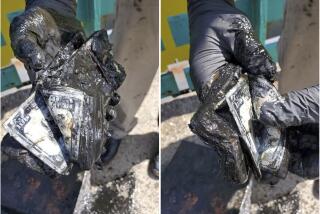U.S. Treasury Seeks Means to Make Counterfeit Cash Easier to Detect
Shay Schmidt committed his crime on his dad’s color photocopier. There, taking advantage of the very latest in copying technology, he and his buddy Jack Williams ran off $15,000 worth of $20 bills and then did what seemed natural with pockets full of free cash. They went shopping.
The two Wichita, Kan., teen-agers eventually were nabbed trying to pass a bogus $20 bill at a garage sale. But their escapade is just one of thousands that have taken greenback counterfeiting to record heights, posing an unprecedented threat to the U.S. currency.
The culprit is not just the rise of sophisticated color copiers, which have made astonishingly convincing forgeries possible at the touch of a button, but also the antiquated design of American money, which contains none of the many new anti-counterfeiting techniques that have been adopted by other countries.
Canada has a high-tech patch that changes colors on its new $20 bill and that cannot be photocopied or easily duplicated. Britain has a thick, metallic thread running through its 20-pound note.
Australia has been experimenting with holograms and plastic film instead of paper. Other countries vary the sizes of different denominations and use exotic types of paper.
But the United States? Because of the standardized design of American bank notes, some counterfeiters have taken to bleaching $1 bills and printing $20 notes over the paper, a technique that has produced bills that not only look like real money, but also have the greenback’s grainy feel.
“It used to be that if someone wanted to do a decent job of counterfeiting, they had to have a certain skill in printing technology,” said Dave Robbins, an anti-counterfeiting expert at Battelle Laboratories in Ohio. “They had to know how to make an offset plate. Now all the skill’s been taken out of it.”
According to the Treasury Department, this problem will not last forever. By the early 1990s, all bills will have the words “United States of America” printed around the presidential portraits in letters too small to be picked up by even the best copying machines.
To foil the bleachers, the bills will also have a special polyester thread running from top to bottom just to the left of the portrait. Because the thread will have the denomination of the bill written on it, it will be foolish to simply bleach a $1 bill into a $20 bill. And because the thread is visible only when the bill is held up to the light, it cannot be reproduced by a photocopier.
But because the Treasury is reluctant to change either the style or the color of the traditional greenback, its proposed changes are relatively modest and have been criticized by some currency experts as unlikely to deter anyone but the casual counterfeiter, who usually gets caught anyway.
Working with the latest in printing and design technologies, a number of currency specialists have instead proposed junking the greenback entirely in favor of a dramatic redesign of U.S. money that includes not just microprinting and security threads but a whole grab bag of printing gadgetry and high-tech devices.
“There is nothing that can’t be beat by someone,” said Bob Leuver, former head of the Bureau of Engraving and Printing. “What you want to do is put a multitude of these devices in to make life difficult for the professional. You want to make it so that it can’t be done in an hour.”
Take the question of design. The most difficult parts of the U.S. currency to forge or to duplicate accurately--even on a color copier--are the portrait and the seal. Yet because all U.S. money shares the same color and style, most people distinguish bills by looking at the least problematic part of a counterfeit bill: the numerals in the corners.
This, say many counterfeiting experts, is the single greatest obstacle facing the battle against bogus bills. Most people who receive money do not look at it in such a way as to be able to tell the difference between what is real and what is not.
Although the changes proposed by the Treasury make detection by experts easy, critics say, they do not solve the problem of everyday use. The microprinting around the portraits, for example, is not only too small to be read by a copier, it is also too small to be read by the naked eye. Nor can the so-called “security thread,” which is visible only in transmitted light, be seen without a special effort.
The “ideal” American bank note would be a little more dramatic, the experts say.
Among the proposals:
- Color: The best way to reduce the focus on corner numbers would be to assign each denomination a different color. That, the theory goes, would get store clerks to look at the whole bill. Then the portrait could be enlarged or set off with special graphics to make it the center of attention.
The trick here is not just to use any kind of color graphics, which can, of course, be duplicated by a sophisticated color copier. But certain kinds of inks can cause unusual visual effects that cannot be picked up by a machine.
What is known as front-to-back reproduction, for example, means that color on one side of a bill would shine through and illuminate designs on the other side. For example, a blue tint on the back of the $5 bill might shine through Abraham Lincoln’s eyes on the front.
Other specialized inks give what is known as an iridescent effect, changing colors as the viewing angle changes like a film of oil on a water puddle.
* Optical variable devices: This is essentially high-tech printing, which attempts to make anti-counterfeiting measures so conspicuous that they can be spotted by even the most casual inspection.
In the upper left corner of the new Canadian $20 bill, for example, is a small, rectangular patch that changes color from gold to green when it is tilted under light. Composed of five alternating layers of extremely thin, transparent silica and zirconia welded by an electron-beam gun, the device is extremely difficult for a counterfeiter to duplicate.
Along the same lines, the U.S. company that puts the holograms on credit cards has proposed putting them on bills as well. The process is also tricky, since on a flexible bank note--as opposed to a stiff credit card--a poorly constructed duplicate would crinkle like tin foil.
* Improved paper: One of the weaknesses of the current currency is that ordinary rag paper can pass for the 75% cotton-25% linen mix used in U.S. bills. One alternative would be to supplement the security thread with some kind of highly visible weave.
On the new British 20-pound note, for example, a thick metallic thread weaves up and down through the paper’s thickness, surfacing on the front of the bill every quarter inch. It is not impossible to duplicate, but without the exact paper, a would-be forger would have to paste thin strips of tin foil on the bogus bills one by one.
“Who’s going to stay up all night doing that?” Leuver asked.
* Call in the big bills: This, the most ambitious anti-counterfeiting measure, is premised on the fact that most counterfeits are of large-denomination bills--20s, 50s and larger.
Since credit cards and checks are used more commonly for these amounts anyway, simply ending the use of all big bills would relegate forgers to counterfeiting smaller denominations, a decidedly less cost-effective prospect for big-time criminals.
More to Read
Sign up for Essential California
The most important California stories and recommendations in your inbox every morning.
You may occasionally receive promotional content from the Los Angeles Times.










